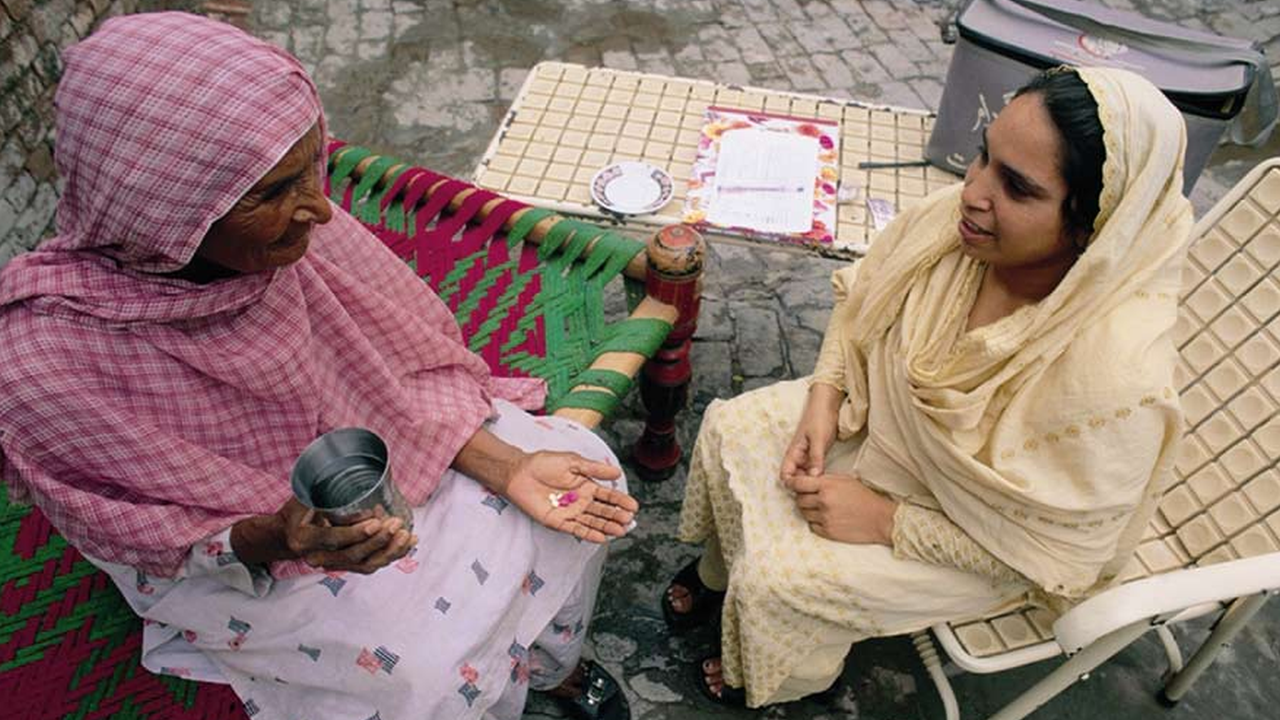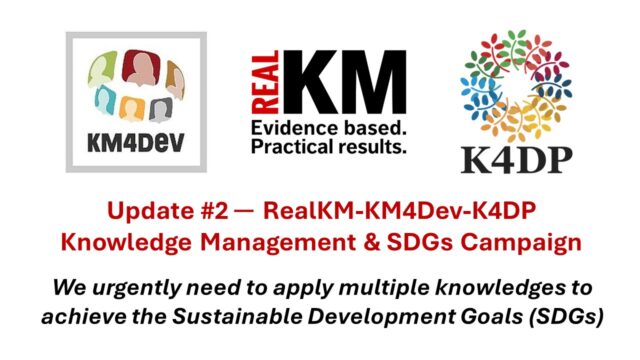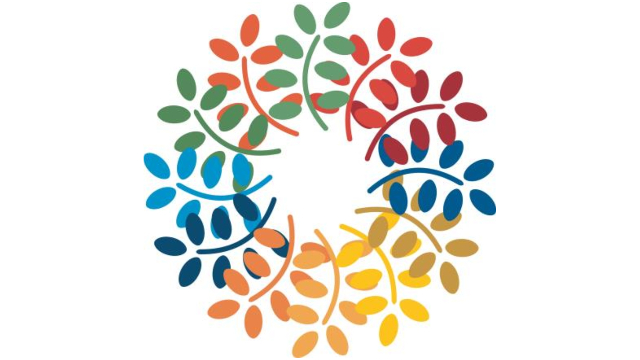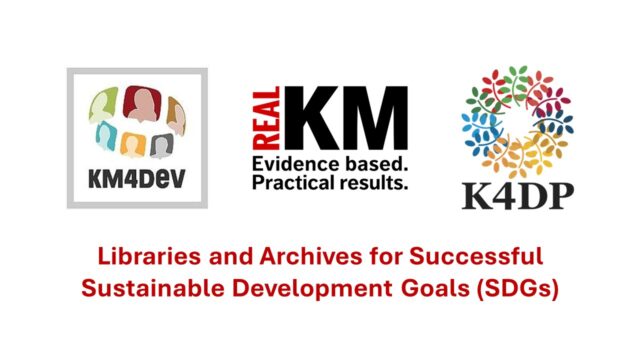
Social enablers and bottom-up approaches for effective knowledge management in sustainable development
In a new RealKM Magazine article, Gladys Kemboi describes an insightful knowledge management (KM) case study in regard to sustainable development and food security systems in Africa. Gladys discusses how she sought out Racheal Ngina, to tap her tacit knowledge and engage her as a knowledge champion for African youths through the Global Knowledge Partnerships Network. Racheal has been using knowledge of dryland agriculture that she gained in Israel to empower the local community in Kenya’s Turkana County, which is one of the hottest, driest regions in the world.
A recent paper1 by Joy Ching-Ya Muller in the The Electronic Journal of Knowledge Management (EJKM) further highlights the importance of the approaches described by Gladys. Muller is currently employed with the Swiss Agency for Development and Cooperation, and has experience in KM, humanitarian, and development work.
KM strategy for Millennium Development Goals
Muller examines the KM strategy to achieve Millennium Development Goals 4 and 5 relating to child and maternal health in Pakistan. The current United Nations Sustainable Development Goals (SDGs) were preceded by the earlier Millennium Development Goals (MDGs). The eight MDGs were to be achieved by 2015.
Two important goals for Pakistan were MDG 4 and 5, because improving maternal, new born, and child health is essential for the country’s development. Specifically, the Government of Pakistan committed to targets to reduce under-5, infant, and maternal mortality rates.
Despite the importance of MDG 4 and 5, pace towards the targets had been slow, and as time passed, it became increasingly unlikely that Pakistan would achieve them by 2015. Muller advises that in response, the Government of Pakistan developed a KM strategy and implementation plans, effective from 2011 to 2015, for better making and applying policies and programs to achieve MDG 4 and 5. The strategy also set up KM functions in the health sector in selected provinces, and identified the KM role of the federal and provincial governments.
However, Muller alerts that while the KM strategy and its implementation plans did set up a structure to involve not only key stakeholders internally but also externally, including relevant UN agencies and other organisations, and provide an idea on knowledge flow, managers were the only target. The involvement of individuals at lower levels was not considered.
KM becomes complex where a greater variety of professional specialisations is found, as there is a greater need for wider participation in KM. Although the strategy highlighted the need for understanding ways people connect as one of the first steps to introduce KM, it did not provide guidance to strengthen social enablers, such as through people, culture, leadership, and the creation of an environment in which trust can flourish. As a result, the expected outputs of the strategy were limited to focusing on improved organisational oversight, enhanced KM structure, and tools.
For instance, and surprisingly, the role of Lady Health Workers was barely mentioned in the KM strategy, despite having been introduced in 2007 to support MDG 4 and 5 as part of Pakistan’s National Maternal, Neonatal, and Child Health (MNCH) Program.
Neglecting the Lady Health Workers
For KM to improve maternal and child health, Muller advises that it needs to capture social issues as determinants of health, such as poverty, malnutrition, gender inequality, and illiteracy. The Lady Health Workers network, with its community-based presence and understanding of the local customs and languages, has been appreciated by the community, enabling Lady Health Workers to play a catalyst role in bringing neighbours closer together.
Muller contends that the social capital that Lady Health Workers generate at the community level and its potential should not be neglected for KM. With appropriate training and recognition of their role and with improved social-economic status, Lady Health Workers can actively seek out information as required, translating tacit knowledge into explicit knowledge. The creation of knowledge in this way could provide a better picture of health to managers as it covers areas of social determinants of health, and solutions could be found with an integrated approach.
Muller states that in fact, Lady Health Workers have been the agent and starting point at the individual and group levels for KM, and for knowledge application. They have been performing intuiting, interpreting, and integrating – the first three steps of the 4-I framework of organisational learning shown in Figure 1 below. With training, Lady Health Workers could, by interpreting the observations and experiences acquired from their family visits, create required explicit knowledge from tacit knowledge.
This knowledge could then be transferred to Lady Health Supervisors and then as a group, with interpreting and integrating, to generate knowledge at the community and district levels. Knowledge could then be forwarded for provincial level managers’ collection, conversion, monitoring and evaluation.
Supported by an adequate KM system, knowledge could be institutionalised to inform the policy makers of the Government of Pakistan. As the performance of Lady Health Workers is critical for the provision of essential health services to the community in Pakistan, the Government of Pakistan might benefit from further investment in Lady Health Workers’ development to enhance their capacity, so that relevant knowledge could be generated, managed, and applied for health improvement.
The 4-I framework of organisational learning
Muller advises that the learning agenda provided by leaders, therefore, is key for KM and learning to happen at multi-levels (individual, group, and organisation) linking to social interactions within the organisation, for example with activities such as intuiting, interpreting, integrating, and institutionalising as suggested in the 4-I framework in Figure 1.

The 4-I framework recognises multi-level knowledge processes. While intuiting and integrating occur at the individual level, interpreting and integrating occur at the group level, and integrating and institutionalising occur at the organisational level. Muller advises that with clear guidance and demonstration from leaders through their own behaviour for learning, the 4-I can be realised at all levels. It can facilitate the practice becoming a shared value, so as to tie the organisation together for learning to take place across the organisational structure.
Ultimately, Pakistan sadly did not achieve2 its MDG 4 and 5 targets. But this outcome could have been different had social enablers and bottom-up approaches been used as part of an MDG 4 and 5 KM strategy that reflected the 4-I framework. It is therefore critically important to use such approaches to better facilitate the achievement of the SDGs.
Header image source: Country Case Study – Pakistan’s Lady Health Worker Program.
References:
- Muller, J. C.-Y. (2018). Effective Knowledge Management and Organisational Learning in the Context of Sustainable Development. The Electronic Journal of Knowledge Management, 16(1), 56-69. ↩
- Aziz, A., Saleem, S., Nolen, T. L., Pradhan, N. A., McClure, E. M., Jessani, S., … & Goldenberg, R. L. (2020). Why are the Pakistani maternal, fetal and newborn outcomes so poor compared to other low and middle-income countries?. Reproductive Health, 17(3), 1-12. ↩
Also published on Medium.






